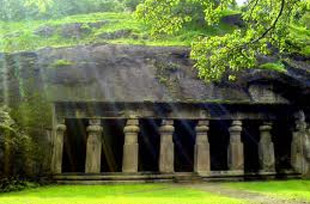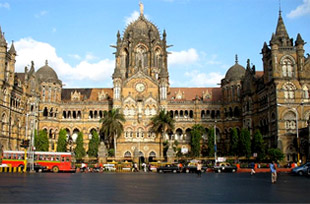
 Mostly visited for – Mumbai, Elephanta Caves- a short ferry side from Mumbai, Aurangabad, Ajanta and Ellora- a virtual gallery of ancient Buddhist and hindu art in the midst of jungles, Lonar crater- formed by the impact of a meteorite nearly 50,000 years ago, Mahabaleshwar, Lonavala, Khandala, Nashik, Pandharpur, Pune, Shirdi, Kolhapur, Murud-Janjira, Nagpur, Ahmednagar, Amravati.
Mostly visited for – Mumbai, Elephanta Caves- a short ferry side from Mumbai, Aurangabad, Ajanta and Ellora- a virtual gallery of ancient Buddhist and hindu art in the midst of jungles, Lonar crater- formed by the impact of a meteorite nearly 50,000 years ago, Mahabaleshwar, Lonavala, Khandala, Nashik, Pandharpur, Pune, Shirdi, Kolhapur, Murud-Janjira, Nagpur, Ahmednagar, Amravati.
Ajanta Caves (Near Aurangabad), Ellora Caves (Near Aurangabad), Elephanta Caves (Near Mumbai), Gateway of India (Mumbai), Haji Ali Mosque (Worli), Bibi-Ka-Maqbara (Near Aurangabad), Daulatabad Fort (Near Aurangabad), Bassein Fort (Mumbai), ‘Chhatrapati’ Shivaji Terminus (Mumbai), Aga Khan Palace (Pune).
Beaches: Bassein, Dahanu-Bordi, Tarkarli, Ganpatiphule, Malwan, Vengurla, Alibagh, Murud, Harihareshwar, Srivardhan, Kelva, Aksa, Arnala, Manori, Gorai, Juhu, Madh Island, Mandwa-Kihim, Marine Drive-Chowpatty, Marve, Manori, Tarkarli
Adventure
Rock Climbing & Trekking, Paragliding, Sailing, Windsurfing, Snorkellling and Scuba Diving
Major Cities – Mumbai, Pune, Nagpur, Nashik, Nanded, Solapur, Thane, Aurangabad, Nagpur, Ahmednagar, Amravati, Kolhapur and Satara.
Weather - Summer: March to May, Monsoon: June to September, Winter: October to February. Climate of Maharashtra is tropical monsoon in nature making summers hot and winters mildly cold.
Connectivity
By Air - Major airports of Maharashtra are based in the cities of Mumbai, Pune and Nagpur.
By Rail – Mumbai is the state’s most important railway terminus. A large number of important trains link the city to other cities of India.
By Road -
History, Geography and Culture of Maharashtra
Maharashtra is a delightful destination of India, summing up a lot of incredible surprises in its share of history, geography and culture. Historically this region came to prominence under the rule of Ashoka the Great, the Mauryan Emperor as an embassy. The reference of Maharashtraka in a Chalukyan inscription and in the accounts of Hiuen Tsang, a Chinese traveller also testifies the presence of this region during his pilgrimage to India.
is a delightful destination of India, summing up a lot of incredible surprises in its share of history, geography and culture. Historically this region came to prominence under the rule of Ashoka the Great, the Mauryan Emperor as an embassy. The reference of Maharashtraka in a Chalukyan inscription and in the accounts of Hiuen Tsang, a Chinese traveller also testifies the presence of this region during his pilgrimage to India.
The Satyavahanas in their heydays established Junnar as their capital (30 miles away from Pune). The state is known for its distinct Buddhist heritage and culture accredited to the famous caves that used to serve as monastic complexes, viharas (hall) and chaityas for Hindu, Buddhist and Jain monks. The state has the largest number of caves, the oldest belonging to the 2nd century B.C. The famous caves of the state are Ajanta Cave complex, which is also the world heritage sites acknowledged for their ancient artistry and brilliance on the rock cut caves dedicated to the growth of Buddhism. Carved during 2nd-6th century period, this cave depicts the sheer mastery of residing monks who made these shelters a canvas of creation. The second recognized world heritage cave site in the city is Ellora Caves which are nothing but a conglomeration of 34 caves dedicated to Buddhist, Hindu and Jain religion. Carved during 5th-7th century, these caves also exhibit the large and multi-storeyed cellular Viharas carved on to mountain faces.
Elephanta Island, 9 km offshore Mumbai features another cave complex dedicated largely to Hindu and a small part of the cave group consists of Buddhist caves. Hewn from the solid basalt rock, these caves got into the shape as artistic marvel during 5th and 8th centuries. Other important rock cut caves in this state are Karla, Bhaja, Pitalkhora, Pandavleni and Kanheri caves.
Mughals also established their control under the rule of Aurangzeb who conquered the most of the Deccan and brought it under Mughal territory. Aurangabad city still preserves the remnants of Mughal influences in the form of Daulatabad Fort and Bibi Ka Maqbara in the heart of the city.
But the region acquired its zenith under the Marathas who rose up to power defeating Mughal, Bahmani and Nizams under the aegis of Chhatrapati Shivaji in the 17th century. This Maratha kingdom was further expanded by Bhonsles of Nagpur, Gaekwads of Baroda, Holkars of Indore, Scindias of Gwalior and Peshwas or the Prime Ministers. The famous Maratha forts of Maharashtra can be explored by visiting Sindhudurg, Vijayadurg, Raigarh and Panhala forts.
During the 19th century, Maratha supremacy ended with the conquering of the East India Company. The British influences in the state came to the fore in the city of seven islands, Mumbai then addressed as Bombay presidency. The British influences in Maharashtra can be gauged through the various monuments intricately laid out in the city. These include Prince of Wales Museum, Chhattrapati Shivaji Terminus then called as Victoria Terminus, Gateway of India, Crawford Market, Watson Hotel, etc. reveal the Victorian influences in the state.
Geographically, this third largest Indian state shares its borders with Madhya Pradesh to the north, Karnataka to the south, Chhattisgarh to the east, Andhra Pradesh to the southeast and Goa to the southwest direction. The union territory of Dadra and Nagar Haveli conjoins the state with the Gujarat as well. The state is lined by the Arabian Sea in the west direction.
The unique topography of this region is renowned for its large Deccan Plateau and Western Ghats better known as Sahyadri. The plateau region in Maharashtra is characterized by Solapur, Pune and Nagpur. The hilly region in Maharashtra can be experienced near Nashik, where the highest elevated point, Kalsubai can be spotted in the state. The major rivers irrigating this state are Godavari, Krishna, Bhima, Purna, Wardha Wainganga, Narmada and Tapi.
The regions in Vidarbha, southern Kolhapur and Sindhudurg feature rich mineral deposits. Coal, iron ore, limestone and manganese deposits are available in abundance, contributing to the wealth of economy. Farming wise, the state is identical with the cotton farming, thanks to the rich deposits of black basalt soil in Deccan. The farming contributions of Maharashtra besides cotton are cereals, mangoes, grapes, oranges, onions, pulses, etc.
Culturally, Maharashtra is a magical tapestry of festivals, traditions, customs and art forms. The state’s capital, Mumbai is the hub of Bollywood, one of the highest grossing entertainment industries in the world. The state is also the center for the country’s finance, thanks to the presence of the India’s largest stock exchange, Bombay Stock Exchange which is also the oldest in the Asian continent. Ganesh Chaturthi celebrated in Aug – Sep every year is also an integral part of Maharashtrian culture. Similarly, the folk dance forms like Lavani, Koli and Powada also exhibit the state’s rich culture in its authentic form.
The epitome of Mahrashtra’s cultural legacy is Deccan Odyssey, a premier luxury train dedicated to the heritage of Maratha kings and their refined culture. This luxury train is an illustrious attempt allowing tourists to enjoy a remarkable sojourn in Deccan’s cultural and natural grandeur comprising serene and unspoilt beaches, magnificent forts, backwaters and colossal heritage tales etched on rocky caves. This weeklong journey is also a great way to experience the finest of Deccan delights on the track to royalty.
Wildlife Sanctuaries
Melghat Tiger Reserve (Amravati district), Nagzira Wild Life Sanctuary, The Navegaon Forest Resort (Vidarbha region), Dajipur Bison Sanctuary (Kolhapur and Sindhudurg districts), Tadoba National Park (Near Chandrapur), Bird Sanctuaries (Sholapur districts), Mahim Nature Park (Bandra Sion Link Road), Karnala Bird Sanctuary (Near Mumbai)
Religion – Hinduism, Islam, Sikhism, Jainism, Buddhism, Zoroastianism and Christianity
Festivals
Nag Panchami
Narali Pournima
Gokul Ashtami celebrating Birth of Lord Krishna
Ganesh Chaturthi
Gudi Padwa
Pola
Dussehra
Diwali
Makar Sankrant
Holi
The Pune Festival
The Banganga Festival
The Elephanta Festival
The Ellora Festival
The Kalidas Festival
Eat – Maharashtra cuisine ranges widely in its flavours. The dishes are either mild or very spicy. The state has also popularized the street food phenomenon along side the frequented beaches. The famous street foods relished by everyone here include Bhel puri, Paav Bhaji, Paani Poori, Vada Pao (Indian Burger), Ussal Pav (bread with mixed vegetables) and Poha (flattened rice), etc. Other popular recipes from the heart of Maharashtra are Kothimbir Vadi Patra, Vaangi Batata Masala (Potato and Eggplant), Karwari Prawns, Soonth Panak, Chakli, etc. Famous desserts of the state are Shankarpali, Singada Chikki Dessert, Puran Poli, Coconut Potali, Karanji, Badam Halwa and Shengdana Chikki (Peanut Caramels).
Buy – The crafts of Maharashtra are equally enticing allowing tourists to splurge on the rich wealth of crafted handicrafts and artifacts. Brocade fabrics, Paithani Sarees, Silk bordered dhotis, Chandrakala sarees, Bidriware crafts, Warli Paintings, Clothing and Jewellery, Kolhapuri Chappals, Narayan Peth and Ajanta Paintings are a few of handicrafts items available in Maharashtra.
Hotels – Hospitality in Maharashtra is followed in adherence to the tradition of the state. Here, tourists can enjoy the hospitality from the numerous options available in beach resorts and five star hotels.